#class 9 coordinate geometry
Explore tagged Tumblr posts
Text
10 Must-Know Tips to Crack the NDA Exam in Your First Attempt

Cracking the National Defence Academy (NDA) exam in your first attempt is a dream for many aspirants. With fierce competition and a rigorous selection process, proper preparation is key. Whether you're aiming for the Army, Navy, or Air Force, these 10 essential tips will help you maximize your chances of success.
1. Understand the NDA Exam Pattern & Syllabus
Before diving into preparation, familiarize yourself with the NDA exam pattern:
Written Exam: Mathematics (300 marks) & General Ability Test (600 marks).
SSB Interview: Psychological tests, group tasks, and personal interviews.
Focus on high-weightage topics like Mathematics (Algebra, Calculus), English, General Knowledge, and Current Affairs.
2. Follow a Structured Study Plan
A disciplined study schedule is crucial. Divide your time between:
Morning: Tough subjects (Maths, Physics).
Afternoon: Revision & practice tests.
Evening: GK, Current Affairs, and English.
3. Master Mathematics – The Game Changer
Maths is a scoring subject if practiced well. Key areas include:
Algebra, Trigonometry, Calculus, and Coordinate Geometry.
Solve previous years’ papers and take timed mock tests.
4. Strengthen Your English & General Knowledge
English: Focus on grammar, comprehension, and vocabulary.
GK: Cover History, Geography, Polity, Science, and Defence-related updates.
Read newspapers like The Hindu and magazines like Pratiyogita Darpan.
5. Stay Updated with Current Affairs
Follow defence news, government schemes, and international events.
Make monthly notes of important happenings.
6. Practice Previous Years’ Papers & Mock Tests
Solving past papers helps identify trends and weak areas.
Take full-length mock tests to improve speed and accuracy.
7. Work on Physical Fitness
The SSB Interview requires good stamina. Start:
Running, push-ups, pull-ups, and swimming.
Maintain a healthy diet and sleep routine.
8. Develop Officer-Like Qualities (OLQs) for SSB
The SSB interview tests leadership, confidence, and decision-making skills.
Participate in group discussions, sports, and extracurricular activities.
Practice psychometric tests and situational response exercises.
9. Improve Time Management During the Exam
Maths Section: Allocate 2.5 minutes per question.
GAT Section: Spend more time on high-mark questions.
Avoid getting stuck on difficult problems—move on and revisit later.
10. Stay Motivated & Consistent
Join study groups or online forums for peer support.
Keep reminding yourself of your end goal—becoming an NDA officer.
Final Words
Cracking the NDA exam in your first attempt requires smart preparation, discipline, and perseverance. If you’re looking for expert guidance, consider enrolling in NDA classes in Dehradun at The Pestle Weed School, known for its structured coaching and success-driven approach. With the right strategy and mentorship, you can turn your NDA dream into reality!
0 notes
Text

The Right Way to Prepare for NDA 2025: A Step-by-Step Guide
Preparing for the National Defence Academy (NDA) 2025 is a milestone for much aspiring defence personnel. Achieving success requires strategy, consistency, and the right mindset. If you're wondering about the best approach, here’s a detailed step-by-step guide to ace NDA 2025.
Step 1: Understand the NDA Exam Pattern
The NDA exam consists of two stages:
Written Exam
Mathematics:
Total Marks: 300
Time: 2.5 hours
General Ability Test (GAT):
Total Marks: 600
Time: 2.5 hours
SSB Interview
Total Marks: 900
Conducted over 5 days to assess personality, leadership, and communication skills.
Step 2: Check Your Eligibility
To avoid disqualification, ensure you meet the eligibility criteria:
Age: Candidates must be born between July 2, 2006, and July 1, 2009, for NDA 2025 (exact dates may vary).
Education:
Army Wing: Class 12 or equivalent pass.
Navy/Air Force Wings: Class 12 with Physics and Mathematics.
Physical Fitness: Follow the Indian Armed Forces' physical standards.
Step 3: Build a Study Plan
Consistency is key. Divide your study time into subjects, and prioritize your weak areas.
Sample Weekly Study Plan
Day
Subject
Topics
Time
Monday
Mathematics
Algebra, Trigonometry
3 hours
Tuesday
GAT (English)
Grammar, Vocabulary
2 hours
Wednesday
GAT (GK)
History, Polity, Geography
2 hours
Thursday
Science
Physics and Chemistry basics
2 hours
Friday
Current Affairs
Newspaper reading and quizzes
1.5 hours
Saturday
Mock Tests
Written Exam Practice
3 hours
Sunday
Physical Training
Running, push-ups, obstacle tasks
1 hour
Step 4: Focus on Subject-Wise Preparation
1. Mathematics
Key Topics: Algebra, Calculus, Coordinate Geometry, Trigonometry.
Use NCERT (Class 11 & 12) and books like R.S. Aggarwal for practice.
Solve at least 30 problems daily.
2. General Ability Test (GAT)
English: Improve grammar, vocabulary, and comprehension.
General Knowledge: Read NCERT books for history, geography, and polity.
Science: Understand Class 10–12 concepts.
3. Current Affairs
Read newspapers like The Hindu or Indian Express.
Watch defence-related updates on YouTube channels like Manasa Defence Academy's Channel.
Step 5: Physical Fitness Preparation
The NDA demands physical fitness. Start with these:
Running: Practice 2.4 km runs daily.
Push-Ups & Pull-Ups: Gradually increase repetitions.
Swimming: Recommended but optional.
Stretching: Avoid injuries with proper warm-ups and cool-downs.
Step 6: Practice SSB Techniques
Develop communication skills through group discussions and debates.
Work on psychological tasks like Thematic Apperception Tests (TAT) and Word Association Tests (WAT).
Participate in mock SSB sessions at reputed academies like Manasa Defence Academy.
Step 7: Take Mock Tests and Solve Previous Papers
Mock tests replicate the real exam experience and identify areas that need enhancement.
Use platforms like Testbook or Manasa Defence Academy's mock test series.
Solve at least 10 years’ worth of previous NDA question papers.
Step 8: Join a Reputed NDA Coaching Center
For structured guidance, enroll in a top coaching center.
Manasa Defence Academy, Visakhapatnam is highly recommended for its comprehensive NDA training.
Benefits include:
Expert faculty.
SSB interview preparation.
Physical fitness and personality development programs.
Step 9: Register for the NDA 2025 Exam
Visit the UPSC official website (www.upsc.gov.in) to:
Fill out the application form.
Upload required documents.
Pay the application fee.
Step 10: Stay Consistent and Motivated
Set small, achievable goals to keep yourself motivated.
Surround yourself with like-minded aspirants or join online forums.
Remember, discipline and hard work are your best allies.
Conclusion
Starting early with a clear strategy will set you apart in the competitive NDA 2025 exam. Combine consistent self-study, professional guidance, and rigorous practice to achieve success. Whether you're self-preparing or joining a coaching academy like Manasa Defence Academy, the right mindset and effort will lead you to the gates of the National Defence Academy.
0 notes
Text
NCERT Books for Class 9: A Comprehensive Guide to Building a Strong Academic Foundation
Class 9 is a crucial stage in a student’s academic journey, as it lays the foundation for higher classes and introduces more complex concepts across all subjects. The National Council of Educational Research and Training (NCERT) books are widely recognized as the primary study material for students in India, especially those enrolled in schools affiliated with the Central Board of Secondary Education (CBSE). These books are meticulously designed to provide in-depth knowledge while ensuring clarity and accessibility for students of varying abilities. This article delves into the significance of NCERT books for Class 9, their unique features, and how they contribute to academic success.

Why Are NCERT Books Important for Class 9?
NCERT books are considered the gold standard for academic study in Indian schools, and this is particularly true for Class 9. Here's why they hold such importance:
Conceptual Clarity: NCERT books emphasize a strong understanding of fundamental concepts. Rather than overloading students with unnecessary details, the content is streamlined to focus on essential ideas. This clarity is crucial in Class 9, as students encounter new topics that form the base for Class 10 and beyond.
Aligned with CBSE Curriculum: These books strictly adhere to the CBSE syllabus, ensuring that students study only what is required for their examinations. This alignment also makes NCERT books the most reliable source for CBSE board exams.
Wide Acceptance in Competitive Exams: NCERT books are highly recommended for competitive exams like JEE, NEET, and UPSC. Class 9 concepts, especially in subjects like Mathematics and Science, form a significant portion of the syllabus for these exams.
Cost-Effective and Accessible: NCERT books are affordable and widely available in print and digital formats. The NCERT’s initiative to provide free e-books on their official website has further improved access to quality education materials.
Features of NCERT Books for Class 9
Structured Presentation: The chapters in NCERT books are well-organized and presented systematically. Each chapter begins with an introduction to the topic, followed by examples, illustrations, and exercises that reinforce the concepts discussed.
Language Simplicity: The language used in NCERT books is straightforward and easy to understand. This ensures that students grasp complex concepts without feeling overwhelmed.
Inclusion of Practical Knowledge: NCERT books often provide real-life examples and applications of theoretical concepts. For instance, Science books include experiments and activities to make learning more engaging and interactive.
Illustrations and Diagrams: Visual aids like diagrams, charts, and tables are extensively used to simplify complex topics, especially in subjects like Science and Geography.
End-of-Chapter Exercises: NCERT books include a variety of questions at the end of each chapter, ranging from objective-type to descriptive questions. These exercises are crucial for exam preparation and help students test their understanding of the topics.
Subject-Wise Overview of NCERT Books for Class 9
1. Mathematics
The NCERT Mathematics book for Class 9 introduces concepts like Polynomials, Coordinate Geometry, and Linear Equations. It emphasizes problem-solving skills and logical reasoning, preparing students for advanced topics in higher classes. Each chapter includes solved examples, practice questions, and summaries for better comprehension.
2. Science
The Science textbook is divided into three sections: Physics, Chemistry, and Biology. Topics such as Motion, Atoms and Molecules, and Diversity in the Living World are presented in a simple yet engaging manner. Practical experiments and activities are included to enhance conceptual understanding.
3. Social Science
Social Science comprises History, Geography, Political Science, and Economics. The books provide a detailed exploration of topics like the French Revolution, Natural Vegetation, Electoral Politics, and Poverty as a Challenge. The use of case studies and maps makes these subjects more relatable and interesting.
4. English
The NCERT English books for Class 9, including "Beehive" and "Moments," focus on language development, comprehension, and creative writing skills. Through prose, poetry, and supplementary stories, these books encourage students to appreciate literature while improving their communication abilities.
5. Hindi and Sanskrit
For language subjects like Hindi and Sanskrit, NCERT books introduce students to grammar, vocabulary, and literary works. These books aim to strengthen linguistic skills while fostering an appreciation for India’s rich literary heritage.
Conclusion
NCERT books for Class 9 are invaluable resources that provide a solid foundation for academic success. Their focus on conceptual clarity, simplicity, and relevance ensures that students are well-prepared for both school exams and competitive exams. By thoroughly studying NCERT books and utilizing their exercises effectively, Class 9 students can achieve a deeper understanding of their subjects and build confidence for future challenges. Embracing these books as a primary study resource is a step toward academic excellence and holistic learning. Originally Published: Blogspot.com
#khansir#upscstudymaterials#book for ncert#book ncert download#ncert book for upsc#studying#books#ncert book for class 9#ncert book for class 9 maths
0 notes
Text
SSC higher math Coordinate geometry (স্থানাঙ্ক জ্যামিতি) exercise 11.1 solution
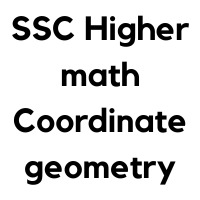
SSC higher math Coordinate geometry (স্থানাঙ্ক জ্যামিতি) exercise 11.1 solution
স্থানাঙ্ক জ্যামিতি সূত্র, স্থানাঙ্ক জ্যামিতি class 10, স্থানাঙ্ক জ্যামিতি অনুশীল, বিন্দুর স্থানাঙ্ক নির্ণয়,দুই বিন্দুর দুরত্ব নির্ণয় স্থানাঙ্ক জ্যামিতি: বিন্দু সমূহের মধ্যবর্তী দূরত্ব, স্থানাঙ্ক দ্বারা ত্রিভুজ, চতুর্ভুজ অঙ্কন ও যাচাই প্রশ্ন ॥ ১ ॥ প্রতিক্ষেত্রে প্রদত্ত বিন্দুসমূহের মধ্যবর্তী দূরত্ব নির্ণয় কর। i. (2, 3) ও (4, 6) সমাধান : ⸫ মনে করি, প্রদত্ত বিন্দুদ্বয় P(2, 3) এবং Q(4, 6) বিন্দু দুইটির মধ্যবর্তী দূরত্ব PQ = একক = একক = একক = একক নির্ণেয় দূরত্ব = একক। ii. (- 3, 7) ও (-7, 3) সমাধান : মনে করি, প্রদত্ত বিন্দুদ্বয় P(- 3, 7) এবং Q (-7, 3) ⸫ বিন্দু দুইটির মধ্যবর্তী দূরত্ব PQ = একক = একক = একক = একক = একক = একক নির্ণেয় দূরত্ব = একক। iii. (a, b) ও (b, a) সমাধান : মনে করি, প্রদত্ত বিন্দুদ্বয় P(a, b) এবং Q(b, a) ⸫ বিন্দু দুইটির মধ্যবর্তী দূরত্ব PQ = একক = একক = একক = একক = একক নির্ণেয় দূরত্ব = একক। Class 9 math chapter 17 solution iv. (0, 0) ও (sinθ, cosθ) সমাধান : মনে করি, প্রদত্ত বিন্দুদ্বয় P(0, 0) এবং Q(sinθ, cosθ) �� ⸫ বিন্দু দুইটির মধ্যবর্তী দূরত্ব PQ = একক = একক = = 1 একক নির্ণেয় দূরত্ব = 1 একক। v. এবং সমাধান : মনে করি, প্রদত্ত বিন্দুদ্বয় P এবং Q ⸫ বিন্দু দুইটির মধ্যবর্তী দূরত্ব PQ = একক = একক = একক একক = একক = একক = একক নির্ণেয় দূরত্ব = একক। প্রশ্ন ॥ ২ ॥ একটি ত্রিভুজের শীর্ষত্রয় যথাক্রমে A(2, - 4), B( - 4, 4) ও C(3, 3)| ত্রিভুজটি অঙ্কন কর এবং দেখাও যে, এটি একটি সমদ্বিবাহু ত্রিভুজ। সমাধান : প্রদত্ত বিন্দুসমূহ A(2, - 4), B( - 4, 4) ও C(3, 3)। XY সমতলে বিন্দুগুলোর অবস্থান দেখানো হলো A, B; B, C এবং C, A যোগ করে ত্রিভুজটি অঙ্কন করা হলো :
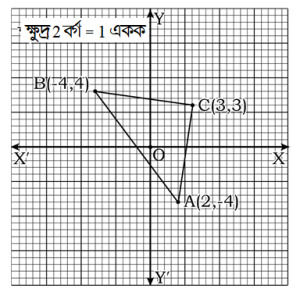
এখন, ABC ত্রিভুজের AB বাহুর দৈর্ঘ্য = একক = একক = একক = একক = 10 একক। BC বাহুর দৈর্ঘ্য = একক = একক = একক = একক = একক। এবং AC বাহুর দৈর্ঘ্য = একক = একক = একক = একক = একক। যেহেতু ABC ত্রিভুজে, BC বাহুর দৈর্ঘ্য = AC বাহুর দৈর্ঘ্য। সুতরাং ABC ত্রিভুজ একটি সমদ্বিবাহু ত্রিভুজ। (দেখানো হলো) প্রশ্ন ॥ ৩ ॥ A(2, 5), B( - 1, 1) ও C(2, 1) একটি ত্রিভুজের শীর্ষত্রয়। ত্রিভুজটি আঁক ও দেখাও যে, এটি একটি সমকোণী ত্রিভুজ। সমাধান : দেওয়া আছে, একটি ত্রিভুজের শীর্ষত্রয় A(2, 5), B( - 1, 1) ও C(2, 1) । XY সমতলে বিন্দুত্রয়ের অবস্থান দেখানো হলো এবং এদের দ্বারা গঠিত ত্রিভুজটি দেখানো হলো।

এখন, ABC ত্রিভুজের AB বাহুর দৈর্ঘ্য = একক = একক = একক = একক = 5 একক। To know more about mathematics BC বাহুর দৈর্ঘ্য = একক = একক = একক = 3 একক এবং AC বাহুর দৈর্ঘ্য = একক = একক = একক = একক = 4 একক। সুতরাং AB2 = 52 = 25 BC2 = 32 = 9 AC2 = 42 = 16 ∴ AC2 + BC2 = 16 + 9 = 25 = AB2 অতএব, ABC একটি সমকোণী ত্রিভুজ। (দেখানো হলো) প্রশ্ন ॥ ৪ ॥ A(1, 2), B( - 3, 5) ও C(5, - 1) বিন্দুত্রয় দ্বারা ত্রিভুজ গঠন করা যায় কিনা যাচাই কর। সমাধান : আমরা জানি, যেকোনো ত্রিভুজের দুই বাহুর সমষ্টি তৃতীয় বাহু অপেক্ষা বৃহত্তর। মনে করি, ABC একটি ত্রিভুজ এবং AB, BC ও AC এর তিনটি বাহু। এখানে, AB বাহুর দৈর্ঘ্য = একক = একক = একক = একক = 5 একক। BC বাহুর দৈর্ঘ্য = একক = একক = একক = = 10 একক এবং AC বাহুর দৈর্ঘ্য = একক = একক = একক = একক = 5 একক। এখানে, AB + AC = 5 + 5 = 10 = BC অর্থাৎ দুই বাহুর সমষ্টি তৃতীয় বাহুর সমান। ⸫ বিন্দু তিনটি একই সরলরেখায় অবস্থান করে অর্থাৎ বিন্দু তিনটি দ্বারা ত্রিভুজ গঠন করা যাবে না। প্রশ্ন ॥ ৫ ॥ মূলবিন্দু থেকে ( - 5, 5) ও (5, k) বিন্দুদ্বয় সমদূরবর্তী হলে k এর মান নির্ণয় কর। সমাধান : মনে করি, প্রদত্ত বিন্দুদ্বয় ( - 5, 5) ও (5, k) এবং মূলবিন্দু O(0, 0)। সুতরাং, দূরত্ব OA = একক = একক = একক = একক। এবং দূরত্ব OB = = = একক। যেহেতু, OA = OB সুতরাং = বা, = 50 বা, = 50 - 25 বা, = 25 ⸫ k = ± 5 নির্ণেয় মান k = ± 5 প্রশ্ন ॥ ৬ ॥ দেখাও যে, A(2, 2), B( - 2, - 2) এবং C() একটি সমবাহু ত্রিভুজের শীর্ষবিন্দু। এর পরিসীমা তিন দশমিক স্থান পর্যন্ত নির্ণয় কর। সমাধান : XY সমতলে A(2, 2), B( - 2, - 2) এবং C( ) বিন্দুগুলোর অবস্থান চিহ্নিত করা হলো :

এখানে, AB বাহুর দৈর্ঘ্য = একক = একক = একক = একক = একক। BC বাহুর দৈর্ঘ্য = একক = একক = একক = একক = একক = একক = একক। এবং AB বাহুর দৈর্ঘ্য = একক = একক = একক = একক = একক = একক = একক। এখানে, AB বাহুর দৈর্ঘ্য = BC বাহুর র্দৈঘ্য = AC বাহুর দৈর্ঘ্য। সুতরাং ABC ত্রিভুজ একটি সমবাহু ত্রিভুজ এবং A, B, C বিন্দুত্রয় ত্রিভুজটির শীর্ষবিন্দু। আবার, ABC ত্রিভুজের পরিসীমা = AB + BC + AC = + + একক = একক = 16.971 একক (Ans.) প্রশ্ন ॥ ৭ ॥ দেখাও যে, A( - 5, 0), B(5, 0), C(5, 5) ও D( - 5, 5) একটি আয়তক্ষেত্রের চারটি শীর্ষবিন্দু। সমাধান : XY সমতলে A( - 5, 0), B(5, 0), C(5, 5) ও D( - 5, 5) বিন্দু চারটির অবস্থান চিহ্নিত করা হলো :
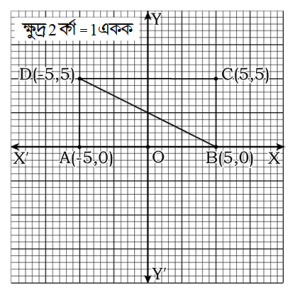
এখানে, AB বাহুর দৈর্ঘ্য = একক = একক = 10 একক। CD বাহুর দৈর্ঘ্য = একক = একক = একক = 10 একক। ⸫ AB বাহুর দৈর্ঘ্য = CD বাহুর দৈর্ঘ্য আবার, AD বাহুর দৈর্ঘ্য = একক = একক = একক = 5 একক। BC বাহুর দৈর্ঘ্য = একক = একক = একক = 5 একক। ⸫ AD বাহুর দৈর্ঘ্য = BC বাহুর দৈর্ঘ্য ⸫ ABCD চতুর্ভুজটির বিপরীত বাহুগুলোর দৈর্ঘ্য সমান। সুতরাং ABCD একটি সামান্তরিক বা আয়তক্ষেত্র। এখন, BD কর্ণের দৈর্ঘ্য = একক = একক = একক = একক = একক এখন BD2 = = 25 × 5 = 125 AB2 = 102 = 100 AD2 = 52 = 25 ∴ AB2 + AD2 = 100 + 25 = 125 ∴ BD2 = AB2 + AD2 পিথাগোরাসের উপপাদ্য অনুসারে ABD একটি সমকোণী ত্রিভুজ এবং BAD সমকোণ। সুতরাং ABCD একটি আয়তক্ষেত্র। অর্থাৎ বিন্দু চারটি একটি আয়তক্ষেত্রের শীর্ষবিন্দু। (দেখানো হলো) প্রশ্ন ॥ ৮ ॥ A( - 2, - 1), B(5, 4), C(6, 7) এবং D( - 1, 2) দ্বারা গঠিত চতুর্ভুজটি সামান্তরিক না আয়তক্ষেত্র তা নির্ণয় কর। সমাধান : XY সমতলে A( - 2, - 1), B(5, 4), C(6, 7) এবং D( - 1, 2) বিন্দু চারটির অবস্থান চিহ্নিত করা হলো :

এখানে, AB বাহুর দৈর্ঘ্য = একক = একক = একক = একক = একক। CD বাহুর দৈর্ঘ্য = একক = একক = একক = একক। ⸫ AB বাহুর দৈর্ঘ্য = CD বাহুর দৈর্ঘ্য আবার, AD বাহুর দৈর্ঘ্য = একক = একক = একক = একক। BC বাহুর দৈর্ঘ্য = একক = একক = একক = একক। ⸫ AD বাহুর দৈর্ঘ্য = BC বাহুর দৈর্ঘ্য সুতরাং ABCD চতুর্ভুজের বিপরীত বাহুগুলোর দৈর্ঘ্য সমান। ⸫ ABCD একটি সামান্তরিক বা আয়তক্ষেত্র। এখন, AC কর্ণের দৈর্ঘ্য = একক = একক = একক = একক = একক। এবং BD কর্ণের দৈর্ঘ্য = একক = একক = একক = একক = একক। ⸫ AC কর্ণের দৈর্ঘ্য ≠ BD কর্ণের দৈর্ঘ্য সুতরাং ABCD একটি সামান্তরিক। অর্থাৎ বিন্দু চারটি দ্বারা গঠিত চতুর্ভুজটি একটি সামান্তরিক। প্রশ্ন ॥ ৯ ॥ A(10, 5), B(7, 6), C ( - 3, 5) বিন্দুগুলোর মধ্যে কোনটি P(3, - 2) এর সবচেয়ে নিকটবর্তী ও কোনটি সবচেয়ে দূরবর্তী। সমাধান : প্রদত্ত বিন্দুগুলো যথাক্রমে A(10, 5), B(7, 6), C ( - 3, 5) এবং P(3, - 2) । P হতে যথাক্রমে A, B, C বিন্দুগুলোর দূরত্ব নির্ণয় করি। ⸫ দূরত্ব PA = একক = একক = একক = একক = 9.899 একক (প্রায়)। দূরত্ব PB = একক = একক = একক = একক = 8.944 একক (প্রায়)। দূরত্ব PC = একক = একক = একক = একক = 9.220 একক (প্রায়)। সুতরাং P হতে B এর দূরত্ব কম এবং A এর দূরত্ব বেশি। ⸫ P বিন্দুর সবচেয়ে নিকটবর্তী বিন্দু B এবং সবচেয়ে দূরবর্তী বিন্দু A. প্রশ্ন ॥ ১০ ॥ P(x, y) বিন্দু থেকে y-অক্ষের দূরত্ব এবং Q(3, 2) বিন্দুর দূরত্ব সমান। প্রমাণ কর যে, y2 - 4y - 6x + 13 = 0 সমাধান : এখানে, P(x, y) বিন্দু থেকে y অক্ষের দূরত্ব = x এবং P(x, y) বিন্দু থেকে Q(3, 2) বিন্দুর দূরত্ব = একক = একক = একক প্রশ্নমতে, = x বা, বা, ⸫ (প্রমাণিত) Read the full article
#Pxyবিন্দুথেকেyঅক্ষেরদূরত্বকত#দুইবিন্দুরদুরত্বনির্ণয়#বিন্দুরস্থানাঙ্কনির্ণয়#স্থানাংকজ্যামিতিclass9#স্থানাঙ্কজ্যামিতিclass10#স্থানাঙ্কজ্যামিতিঅংক#স্থানাঙ্কজ্যামিতিঅনুশীল#স্থানাঙ্কজ্যামিতিসূত্র
0 notes
Text
Best NCERT Solutions for Class 9 Maths – Free and Detailed
Get the best NCERT solutions for Class 9 Maths with detailed explanations and step-by-step answers for each question. These NCERT solutions are ideal for mastering difficulttopics, revising key concepts, and acing exams. Download free PDFs for all chapters and improve your understanding of topics like probability, coordinate geometry, and algebra. Start your preparation today!
0 notes
Text
Benefits of Learning: Digital Classes for 9th & 10th Math and Science

We all know that 9th and 10th class math and science could be difficult. It is generally the first important year of examinations for students, which can be difficult. Parents frequently believe that taking their children to extra classes would help them perform better. While this may be true, it might be difficult for students.
That’s the reason why online courses come in useful. They work similarly to smart classrooms, allowing students to view and engage with the material they are studying. Instead of simply remembering information, people may observe how things function. Learning becomes as simple as installing an app!

Now, students in 9th and 10th grade do not have worries about their classes. Using digital class apps allows them to follow along with their math and science classes. It helps them understand every detail and increases their problem-solving abilities.
Students can also access lessons from other educational platforms when taking classes digitally. Therefore, you are free to explore different syllabi while you are studying the current one. These days, learning is more about truly understanding things than taking exams.
Also, look at the most recent 9th and 10th class syllabuses, which may be helpful!
Class 9 Math's: Unit-wise
Unit 1-Real numbers
Unit 2-Polynomials and Factorization
Unit 3-The Elements of Geometry
Unit 4-Lines and Angles
Unit 5-Co-Ordinate Geometry
Unit 6-Linear Equations in Two Variables
Unit 7-Triangles
Unit 8-Quadrilaterals
Unit 9-Statistics
Unit 10-Surface Areas and Volumes
Unit 11-Areas
Unit 12-Circles
Unit 13-Geometrical Constructions
Unit 14-Probability
Unit 15-Proofs in Mathematics
Class 9 Physics Syllabus: Chapter-wise
Chapter 1-Matter Around Us
Chapter 2-Motion
Chapter 3-Laws of Motion
Chapter 4-Refraction of Light at Plane Surfaces
Chapter 5-Gravitation
Chapter 6-Is Matter Pure?
Chapter 7-Atoms and Molecules
Chapter 8-Floating Bodies
Chapter 9-What is inside the Atom?
Chapter 10-Work and Energy
Chapter 11-Heat
Chapter 12-Sound
Class 9 Biology Syllabus: Chapter-wise
Chapter 1-Cell its structure and functions
Chapter 2-Plant tissues
Chapter 3-Animal tissues
Chapter 4-Plasma membrane
Chapter 5-Diversity in Living Organism
Chapter 6-Sense Organs – I
Chapter 7-Sense Organs – II
Chapter 8-Animal behavior
Chapter 9-Challenges in Improving Agricultural Products
Chapter 10-Adaptations in Different Ecosystems
Chapter 11-Soil pollution
Chapter 12-Bio geochemical cycles
The Telangana State Board (TS) students who are looking for the Class 9 Physics, Biology Syllabus can find it in the syllabus mentioned above. moreover, review the AP Class 9th syllabus also.
Class 10 Math and Science Syllabus:
The Telangana State Board Class 10 math's syllabus is given below; class tenth With the use of this TS 10th Class Math's Textbooks Syllabus, students may prepare for their final exams and have an effective understanding of the subject matter, therefore achieving the highest marks possible.
10th Class Math's: Unit Wise
Unit 1-Real numbers
Unit 2-Sets
Unit 3-Polynomials
Unit 4-Pair of Linear Equations in Two Variables
Unit 5-Quadratic Equations
Unit 6-Progressions
Unit 7-Coordinate Geometry
Unit 8-Similar Triangles
Unit 9-Tangents and Secants to a Circle
Unit 10-Mensuration
Unit 11-Trigonometry
Unit 12-Applications of Trigonometry
Unit 13-Probability
Unit 14-Statistics
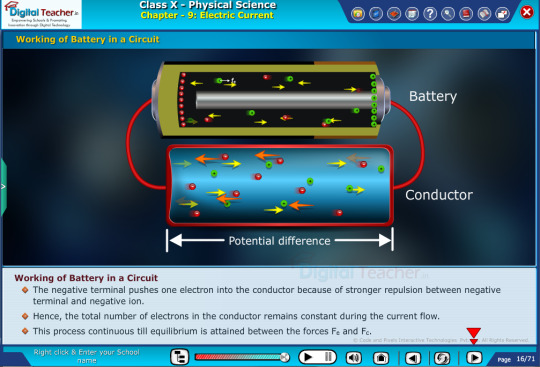
Class 10 Physics Syllabus: Chapter Wise
Chapter 1-Reflection of Light by Different Surfaces
Chapter 2-Chemical Reactions and Equations
Chapter 3-Acids, Bases and Salts
Chapter 4-Refraction of Light at Curved Surfaces
Chapter 5-Human Eye and Colorful World
Chapter 6-Structure of Atom
Chapter 7-Classification of Elements – Periodic Table
Chapter 8-Chemical Bonding
Chapter 9-Electric Current
Chapter 10-Electromagnetism
Chapter 11-Principles of Metallurgy
Chapter 12-Carbon and Compounds
10th Class Biology Syllabus: Chapter-Wise
Chapter 1-Nutrition
Chapter 2-Respiration
Chapter 3-Transportation
Chapter 4-Excretion
Chapter 5-Coordination
Chapter 6-Reproduction
Chapter 7-Coordination in Life Processes
Chapter 8-Heredity
Chapter 9-Our Environment
Chapter 10-Natural Resources
The TS Board Class 10 Math's & Science topic syllabus is available above, complete with chapter-by-chapter details. Students can go through the most recent math and science syllabus to be aware of all the key subjects they need to study for exams.
Additionally, visit the below pages. We hope you found these pages useful:
Telangana Board Syllabus Related Links
Telangana Board Class 6 Syllabus
Telangana Board Class 7 Syllabus
Telangana Board Class 8 Syllabus
Telangana Board Class 9 Syllabus
#elearning#digital class#digital classes online#digital classroom#digital content#digital learning#digital teacher#smart class#online learning
1 note
·
View note
Video
youtube
NCERT Exemplar class 9 | Chapter 3 | coordinate geometry | Solution |#nc...
0 notes
Text
Plotting points on cartesian plane = plotting high score in class 10. How?
Cartesian Plane
QuadrantsAbscissa Ordinate
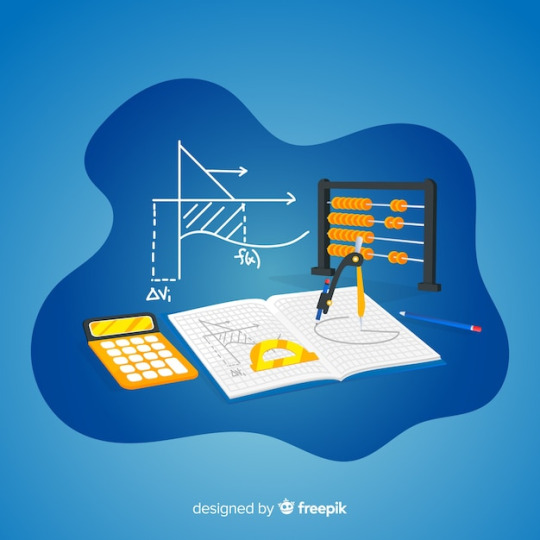
Heard about these terms? Sounds quite fancy, right? What if these terms can increase the chances of you getting a better score in class 10 Maths? Confident about this little chapter? Take a test on SeekoG about coordinate geometry in class 9 to know how much you know.
Why take a test in class 9?
Because strong basics lead to better scores. Take a test so you don’t miss out on anything! Being a small chapter, coordinate geometry does not usually get the required attention from the students. But this small chapter consists of concepts that can get confusing at times. These huge confusions could be solved by simple basics of the chapter. So, what could be the most basic question about the chapter?
How does coordinate geometry work?
What kind of questions will be there that you need to solve? All right, the term Cartesian Plane is the base of coordinate geometry. How? As the name suggests, it is a plane on which the x and y axis exists and divides the plane into four equal quadrants as you can see in the image below.
Each point on the cartesian plane has a value that could be found by observation. But if you’re told that you need to find out the distance between two points, what would you do? No need to be extremely worried about this. There are methods to find it. By the way, did you know that there is a different formula if one of the two points that are given is the origin/ (0,0)?
Now exactly here when you think that chapter ends, you might go wrong. The tricky part comes here when we talk about one of the methods of finding the distance between two points through Pythagoras’ theorem. Obviously, there are many other concepts that still might be pending so keep preparing.
Wait! Wasn’t Pythagoras’ theorem in the chapters on Triangles? Well, surely it is there as well. If you also remember this concept of Triangles, try taking a test on the SeekoG app and you will be one step closer to success.
Want a study plan for Triangles? Click here
0 notes
Text
youtube
youtube
0 notes
Photo

Download MCQs for Class 9 Coordinate Geometry for important topics for all chapters in Class 9 Coordinate Geometry based on CBSE and NCERT pattern. Multiple choice questions help to develop understanding of all key points of chapter. Download latest MCQs for Class 9 Coordinate Geometry in pdf free
https://www.studiestoday.com/multiple-choice-questions/458/coordinate-geometry.html
0 notes
Text
They're here!
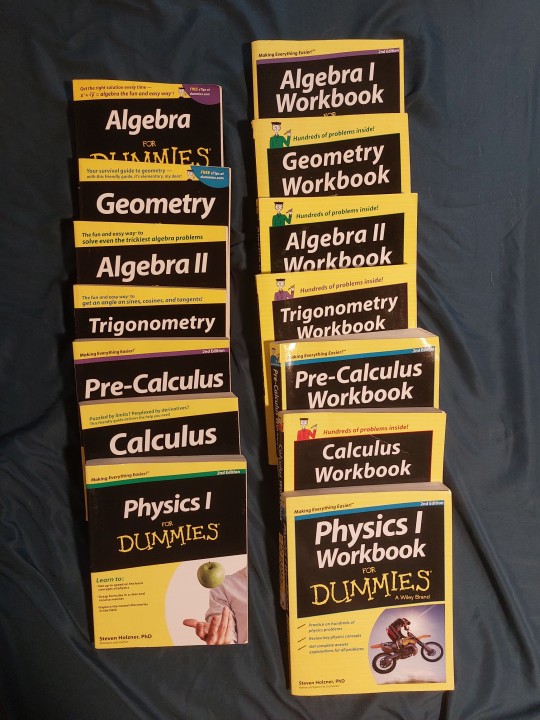
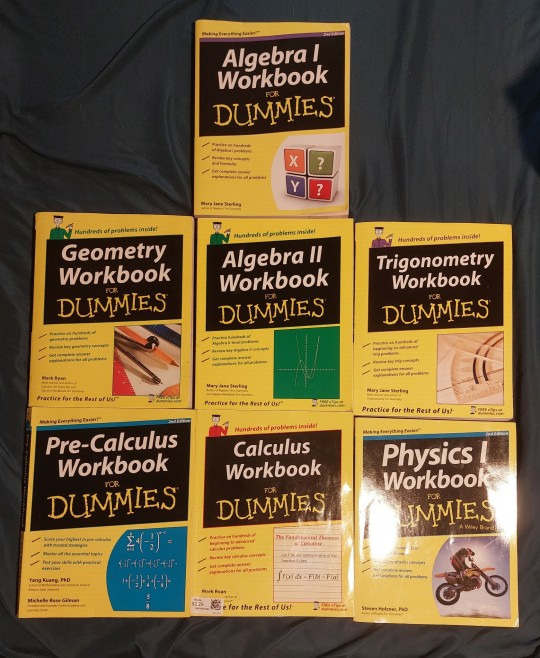
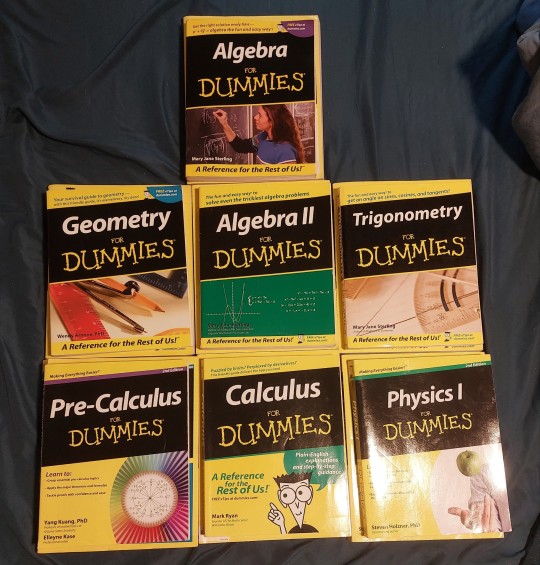
The geometry workbook is by a different author, and the pre-calc workbook has a different co-author, but all the rest are matching sets.
My plan is to go back to school next year to get a second bachelor's degree in astrophysics, a dream of mine that I abandoned in my freshman year because I was lazy and depressed and burned out. I eventually graduated with a BA in English, which is by far the greatest regret of my life. After 4½ years of doing nothing but complain about it and wallow in what could have been, I decided last month to get my ass in gear and commit to the field I originally intended back in 2014.
It's been 9 years since I graduated high school, and I've forgotten pretty much everything beyond simple geometry and a vague awareness of trigonometric functions (I've retained no calculus whatsoever). If I'm going to pursue astrophysics, I'm not only going to need to relearn all this math, I'm going to need to master it. I can't just eke by with a passing C, I need to know every subject backwards and forwards while blindfolded. I already have the pre-req credits to get into the advanced math and physics classes for the major, I just need to refresh myself. I was able to pass trig and AP calc and physics back when I was a punkass teenager, I'm sure I can do it again now that I actually give a shit.
I procrastinated all throughout May because I didn't know if I had it in me to master seven courses in one year, but the workbooks all arrived this morning and now I'm feeling a lot better about my chances. Flipping through algebra 1, I've encountered nothing but softball questions like "which is bigger, -5 or -2?" and "find coordinate (1,3) on this graph." I have no doubt in my mind that this is going to be an absolute cakewalk. Like riding a bike, it'll all come back to me as I work my way through it. I can knock out algebra 1 in a few days, two weeks tops, but I'm less confident in my latent geometry skills, so the cakewalk will serve mostly to temper myself for the challenges ahead. If I jumped right into the hard parts, I'd get overwhelmed and give up like I my first time around, so I need to start small.
I'll be deriving and integrating in no time!
#math#my plan#algebra#geometry#trigonometry#calculus#trig#precalc#calc#high school#college#university#wish me luck
96 notes
·
View notes
Text

How to Start Preparing for NDA 2025: A Complete Guide
To crack the National Defence Academy (NDA) Exam 2025, starting early and adopting a structured approach is crucial. Whether you're a school student or a recent graduate, this guide will help you understand the steps to prepare effectively.
Step 1: Understand the NDA Exam Structure
The NDA exam is held twice a year by the Union Public Service Commission (UPSC). Here's an overview:
Written Exam
Mathematics
Total Marks: 300
Duration: 2.5 hours
General Ability Test (GAT)
Total Marks: 600
Duration: 2.5 hours
Includes sections like English, General Knowledge, Current Affairs, and Science.
SSB Interview
Total Marks: 900
A 5-day process testing intelligence, personality, and leadership skills.
Step 2: Check Eligibility Criteria
Before starting preparation, ensure you meet the NDA 2025 eligibility:
Age Limit: Candidates must be born between July 2, 2006, and July 1, 2009 (for NDA I 2025).
Educational Qualification:
Army Wing: Passed Class 12 or equivalent.
Air Force & Naval Wings: Passed Class 12 with Physics and Mathematics.
Nationality: Indian citizen or specified categories as per UPSC rules.
Physical Standards: Meet the physical fitness criteria specified by the Indian Armed Forces.
Step 3: Create a Study Plan
An organized study plan can help you balance preparation and other commitments.
Daily Routine Example
ActivityTimeMathematics Practice2 hoursGAT & Current Affairs2 hoursPhysical Training1.5 hoursRevision1 hourMock Tests & AnalysisWeekly
Step 4: Subject-Wise Preparation Tips
1. Mathematics
Focus on topics like algebra, trigonometry, calculus, and coordinate geometry.
Recommended books:
NCERT Mathematics (Class 11 & 12)
R.S. Aggarwal for NDA Mathematics
2. General Ability Test (GAT)
English: Improve vocabulary, grammar, and comprehension skills.
General Knowledge: Study history, geography, polity, and current affairs.
Science: Focus on Class 10-12 Physics, Chemistry, and Biology basics.
Recommended books:
NCERT Science and Social Studies books
Arihant Pathfinder for NDA
3. Current Affairs
Read newspapers like The Hindu or Indian Express.
Follow monthly magazines like Manorama Yearbook.
Step 5: Focus on Physical Fitness
Start running, swimming, and strength training to build stamina.
Practice basic exercises like push-ups, sit-ups, and pull-ups.
Prepare for the SSB tasks like obstacle courses and endurance drills.
Step 6: Prepare for SSB Interview
Develop leadership qualities and improve communication skills.
Participate in group discussions, debates, and mock interviews.
Recommended book: Breaking the Code of SSB Interviews
Step 7: Take Mock Tests
Solve previous years’ NDA question papers.
Try taking mock tests, either online or in person, to mimic the exam setting.
Analyze your performance and work on weak areas.
Step 8: Join a Coaching Center
Joining a well-respected coaching institute can provide you with valuable structured guidance.
Manasa Defence Academy, Visakhapatnam: Renowned for its comprehensive NDA training programs, including written exams, SSB preparation, and physical training.
Step 9: Register for the Exam
The NDA 2025 application forms will be released on the UPSC official website (www.upsc.gov.in).
Fill out the form, upload the required documents, and pay the fee.
Step 10: Stay Motivated
Break your larger objectives into smaller, manageable goals, and treat yourself when you reach each one.
Stay connected with other aspirants to share tips and experiences.
Conclusion
Preparing for NDA 2025 is a challenging yet rewarding journey. Start early, follow a disciplined schedule, and stay consistent. With the right strategy and hard work, you can achieve your dream of joining the Indian Armed Forces.
Contact:
Manasa Defence Academy
New Gajuwaka Depot, Visakhapatnam.
Andhra Pradesh-530012.
Call: 7799799221, 7799799229
Gmail: [email protected]
1 note
·
View note
Link
This solution contains questions, answers, explanations of the complete Chapter 3 titled 'Coordinate Geometry' of Maths taught in class 9.
You can view them online or download PDF file for future use: https://www.ntseguru.in/ncert-solutions-for-class-9-maths-chapter-3
0 notes
Text
SSC higher math Coordinate geometry (স্থানাঙ্ক জ্যামিতি) exercise 11.1 solution
SSC higher math Coordinate geometry (স্থানাঙ্ক জ্যামিতি) exercise 11.1 solution
স্থানাঙ্ক জ্যামিতি সূত্র, স্থানাঙ্ক জ্যামিতি class 10, স্থানাঙ্ক জ্যামিতি অনুশীল, বিন্দুর স্থানাঙ্ক নির্ণয়,দুই বিন্দুর দুরত্ব নির্ণয় স্থানাঙ্ক জ্যামিতি: বিন্দু সমূহের মধ্যবর্তী দূরত্ব, স্থানাঙ্ক দ্বারা ত্রিভুজ, চতুর্ভুজ অঙ্কন ও যাচাই প্রশ্ন ॥ ১ ॥ প্রতিক্ষেত্রে প্রদত্ত বিন্দুসমূহের মধ্যবর্তী দূরত্ব নির্ণয় কর। i. (2, 3) ও (4, 6) সমাধান : ⸫ মনে করি, প্রদত্ত বিন্দুদ্বয় P(2, 3) এবং Q(4, 6) বিন্দু দুইটির মধ্যবর্তী দূরত্ব PQ = একক = একক = একক = একক নির্ণেয় দূরত্ব = একক। ii. (- 3, 7) ও (-7, 3) সমাধান : মনে করি, প্রদত্ত বিন্দুদ্বয় P(- 3, 7) এবং Q (-7, 3) ⸫ বিন্দু দুইটির মধ্যবর্তী দূরত্ব PQ = একক = একক = একক = একক = একক = একক নির্ণেয় দূরত্ব = একক। iii. (a, b) ও (b, a) সমাধান : মনে করি, প্রদত্ত বিন্দুদ্বয় P(a, b) এবং Q(b, a) ⸫ বিন্দু দুইটির মধ্যবর্তী দূরত্ব PQ = একক = একক = একক = একক = একক নির্ণেয় দূরত্ব = একক। Class 9 math chapter 17 solution iv. (0, 0) ও (sinθ, cosθ) সমাধান : মনে করি, প্রদত্ত বিন্দুদ্বয় P(0, 0) এবং Q(sinθ, cosθ) ⸫ বিন্দু দুইটির মধ্যবর্তী দূরত্ব PQ = একক = একক = = 1 একক নির্ণেয় দূরত্ব = 1 একক। v. এবং সমাধান : মনে করি, প্রদত্ত বিন্দুদ্বয় P এবং Q ⸫ বিন্দু দুইটির মধ্যবর্তী দূরত্ব PQ = একক = একক = একক একক = একক = একক = একক নির্ণেয় দূরত্ব = একক। প্রশ্ন ॥ ২ ॥ একটি ত্রিভুজের শীর্ষত্রয় যথাক্রমে A(2, - 4), B( - 4, 4) ও C(3, 3)| ত্রিভুজটি অঙ্কন কর এবং দেখাও যে, এটি একটি সমদ্বিবাহু ত্রিভুজ। সমাধান : প্রদত্ত বিন্দুসমূহ A(2, - 4), B( - 4, 4) ও C(3, 3)। XY সমতলে বিন্দুগুলোর অবস্থান দেখানো হলো A, B; B, C এবং C, A যোগ করে ত্রিভুজটি অঙ্কন করা হলো :
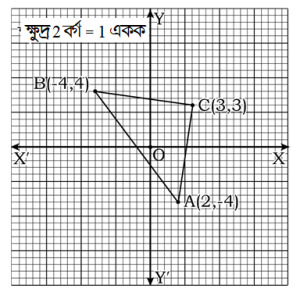
এখন, ABC ত্রিভুজের AB বাহুর দৈর���ঘ্য = একক = একক = একক = একক = 10 একক। BC বাহুর দৈর্ঘ্য = একক = একক = একক = একক = একক। এবং AC বাহুর দৈর্ঘ্য = একক = একক = একক = একক = একক। যেহেতু ABC ত্রিভুজে, BC বাহুর দৈর্ঘ্য = AC বাহুর দৈর্ঘ্য। সুতরাং ABC ত্রিভুজ একটি সমদ্বিবাহু ত্রিভুজ। (দেখানো হলো) প্রশ্ন ॥ ৩ ॥ A(2, 5), B( - 1, 1) ও C(2, 1) একটি ত্রিভুজের শীর্ষত্রয়। ত্রিভুজটি আঁক ও দেখাও যে, এটি একটি সমকোণী ত্রিভুজ। সমাধান : দেওয়া আছে, একটি ত্রিভুজের শীর্ষত্রয় A(2, 5), B( - 1, 1) ও C(2, 1) । XY সমতলে বিন্দুত্রয়ের অবস্থান দেখানো হলো এবং এদের দ্বারা গঠিত ত্রিভুজটি দেখানো হলো।

এখন, ABC ত্রিভুজের AB বাহুর দৈর্ঘ্য = একক = একক = একক = একক = 5 একক। To know more about mathematics BC বাহুর দৈর্ঘ্য = একক = একক = একক = 3 একক এবং AC বাহুর দৈর্ঘ্য = একক = একক = একক = একক = 4 একক। সুতরাং AB2 = 52 = 25 BC2 = 32 = 9 AC2 = 42 = 16 ∴ AC2 + BC2 = 16 + 9 = 25 = AB2 অতএব, ABC একটি সমকোণী ত্রিভুজ। (দেখানো হলো) প্রশ্ন ॥ ৪ ॥ A(1, 2), B( - 3, 5) ও C(5, - 1) বিন্দুত্রয় দ্বারা ত্রিভুজ গঠন করা যায় কিনা যাচাই কর। সমাধান : আমরা জানি, যেকোনো ত্রিভুজের দুই বাহুর সমষ্টি তৃতীয় বাহু অপেক্ষা বৃহত্তর। মনে করি, ABC একটি ত্রিভুজ এবং AB, BC ও AC এর তিনটি বাহু। এখানে, AB বাহুর দৈর্ঘ্য = একক = একক = একক = একক = 5 একক। BC বাহুর দৈর্ঘ্য = একক = একক = একক = = 10 একক এবং AC বাহুর দৈর্ঘ্য = একক = একক = একক = একক = 5 একক। এখানে, AB + AC = 5 + 5 = 10 = BC অর্থাৎ দুই বাহুর সমষ্টি তৃতীয় বাহুর সমান। ⸫ বিন্দু তিনটি একই সরলরেখায় অবস্থান করে অর্থাৎ বিন্দু তিনটি দ্বারা ত্রিভুজ গঠন করা যাবে না। প্রশ্ন ॥ ৫ ॥ মূলবিন্দু থেকে ( - 5, 5) ও (5, k) বিন্দুদ্বয় সমদূরবর্তী হলে k এর মান নির্ণয় কর। সমাধান : মনে করি, প্রদত্ত বিন্দুদ্বয় ( - 5, 5) ও (5, k) এবং মূলবিন্দু O(0, 0)। সুতরাং, দূরত্ব OA = একক = একক = একক = একক। এবং দূরত্ব OB = = = একক। যেহেতু, OA = OB সুতরাং = বা, = 50 বা, = 50 - 25 বা, = 25 ⸫ k = ± 5 নির্ণেয় মান k = ± 5 প্রশ্ন ॥ ৬ ॥ দেখাও যে, A(2, 2), B( - 2, - 2) এবং C() একটি সমবাহু ত্রিভুজের শীর্ষবিন্দু। এর পরিসীমা তিন দশমিক স্থান পর্যন্ত নির্ণয় কর। সমাধান : XY সমতলে A(2, 2), B( - 2, - 2) এবং C( ) বিন্দুগুলোর অবস্থান চিহ্নিত করা হলো :

এখানে, AB বাহুর দৈর্ঘ্য = একক = একক = একক = একক = একক। BC বাহুর দৈর্ঘ্য = একক = একক = একক = একক = একক = একক = একক। এবং AB বাহুর দৈর্ঘ্য = একক = একক = একক = একক = একক = একক = একক। এখানে, AB বাহুর দৈর্ঘ্য = BC বাহুর র্দৈঘ্য = AC বাহুর দৈর্ঘ্য। সুতরাং ABC ত্রিভুজ একটি সমবাহু ত্রিভুজ এবং A, B, C বিন্দুত্রয় ত্রিভুজটির শীর্ষবিন্দু। আবার, ABC ত্রিভুজের পরিসীমা = AB + BC + AC = + + একক = একক = 16.971 একক (Ans.) প্রশ্ন ॥ ৭ ॥ দেখাও যে, A( - 5, 0), B(5, 0), C(5, 5) ও D( - 5, 5) একটি আয়তক্ষেত্রের চারটি শীর্ষবিন্দু। সমাধান : XY সমতলে A( - 5, 0), B(5, 0), C(5, 5) ও D( - 5, 5) বিন্দু চারটির অবস্থান চিহ্নিত করা হলো :

এখানে, AB বাহুর দৈর্ঘ্য = একক = একক = 10 একক। CD বাহুর দৈর্ঘ্য = একক = একক = একক = 10 একক। ⸫ AB বাহুর দৈর্ঘ্য = CD বাহুর দৈর্ঘ্য আবার, AD বাহুর দৈর্ঘ্য = একক = একক = একক = 5 একক। BC বাহুর দৈর্ঘ্য = একক = একক = একক = 5 একক। ⸫ AD বাহুর দৈর্ঘ্য = BC বাহুর দৈর্ঘ্য ⸫ ABCD চতুর্ভুজটির বিপরীত বাহুগুলোর দৈর্ঘ্য সমান। সুতরাং ABCD একটি সামান্তরিক বা আয়তক্ষেত্র। এখন, BD কর্ণের দৈর্ঘ্য = একক = একক = একক = একক = একক এখন BD2 = = 25 × 5 = 125 AB2 = 102 = 100 AD2 = 52 = 25 ∴ AB2 + AD2 = 100 + 25 = 125 ∴ BD2 = AB2 + AD2 পিথাগোরাসের উপপাদ্য অনুসারে ABD একটি সমকোণী ত্রিভুজ এবং BAD সমকোণ। সুতরাং ABCD একটি আয়তক্ষেত্র। অর্থাৎ বিন্দু চারটি একটি আয়তক্ষেত্রের শীর্ষবিন্দু। (দেখানো হলো) প্রশ্ন ॥ ৮ ॥ A( - 2, - 1), B(5, 4), C(6, 7) এবং D( - 1, 2) দ্বারা গঠিত চতুর্ভুজটি সামান্তরিক না আয়তক্ষেত্র তা নির্ণয় কর। সমাধান : XY সমতলে A( - 2, - 1), B(5, 4), C(6, 7) এবং D( - 1, 2) বিন্দু চারটির অবস্থান চিহ্নিত করা হলো :

এখানে, AB বাহুর দৈর্ঘ্য = একক = একক = একক = একক = একক। CD বাহুর দৈর্ঘ্য = একক = একক = একক = একক। ⸫ AB বাহুর দৈর্ঘ্য = CD বাহুর দৈর্ঘ্য আবার, AD বাহুর দৈর্ঘ্য = একক = একক = একক = একক। BC বাহুর দৈর্ঘ্য = একক = একক = একক = একক। ⸫ AD বাহুর দৈর্ঘ্য = BC বাহুর দৈর্ঘ্য সুতরাং ABCD চতুর্ভুজের বিপ���ীত বাহুগুলোর দৈর্ঘ্য সমান। ⸫ ABCD একটি সামান্তরিক বা আয়তক্ষেত্র। এখন, AC কর্ণের দৈর্ঘ্য = একক = একক = একক = একক = একক। এবং BD কর্ণের দৈর্ঘ্য = একক = একক = একক = একক = একক। ⸫ AC কর্ণের দৈর্ঘ্য ≠ BD কর্ণের দৈর্ঘ্য সুতরাং ABCD একটি সামান্তরিক। অর্থাৎ বিন্দু চারটি দ্বারা গঠিত চতুর্ভুজটি একটি সামান্তরিক। প্রশ্ন ॥ ৯ ॥ A(10, 5), B(7, 6), C ( - 3, 5) বিন্দুগুলোর মধ্যে কোনটি P(3, - 2) এর সবচেয়ে নিকটবর্তী ও কোনটি সবচেয়ে দূরবর্তী। সমাধান : প্রদত্ত বিন্দুগুলো যথাক্রমে A(10, 5), B(7, 6), C ( - 3, 5) এবং P(3, - 2) । P হতে যথাক্রমে A, B, C বিন্দুগুলোর দূরত্ব নির্ণয় করি। ⸫ দূরত্ব PA = একক = একক = একক = একক = 9.899 একক (প্রায়)। দূরত্ব PB = একক = একক = একক = একক = 8.944 একক (প্রায়)। দূরত্ব PC = একক = একক = একক = একক = 9.220 একক (প্রায়)। সুতরাং P হতে B এর দূরত্ব কম এবং A এর দূরত্ব বেশি। ⸫ P বিন্দুর সবচেয়ে নিকটবর্তী বিন্দু B এবং সবচেয়ে দূরবর্তী বিন্দু A. প্রশ্ন ॥ ১০ ॥ P(x, y) বিন্দু থেকে y-অক্ষের দূরত্ব এবং Q(3, 2) বিন্দুর দূরত্ব সমান। প্রমাণ কর যে, y2 - 4y - 6x + 13 = 0 সমাধান : এখানে, P(x, y) বিন্দু থেকে y অক্ষের দূরত্ব = x এবং P(x, y) বিন্দু থেকে Q(3, 2) বিন্দুর দূরত্ব = একক = একক = একক প্রশ্নমতে, = x বা, বা, ⸫ (প্রমাণিত) Read the full article
#Pxyবিন্দুথেকেyঅক্ষেরদূরত্বকত#দুইবিন্দুরদুরত্বনির্ণয়#বিন্দুরস্থানাঙ্কনির্ণয়#স্থানাংকজ্যামিতিclass9#স্থানাঙ্কজ্যামিতিclass10#স্থানাঙ্কজ্যামিতিঅংক#স্থানাঙ্কজ্যামিতিঅনুশীল#স্থানাঙ্কজ্যামিতিসূত্র
0 notes
Video
youtube
RBSE Class 10 Math | Coordinate Geometry Miscellaneous Exercise 9 | Chapter 9 Class 10 Maths NCERT RBSE Class 10 Math | Coordinate Geometry Miscellaneous Exercise 9 | Chapter 9 Class 10 Maths NCERT
0 notes
Photo

Social Science Class 9 - https://www.extramarks.com/ncert-solutions/cbse-class-9/social-science
#Social Science Class 9#quadratic equation class 10#ncert physics solution for 12th#biosketch#coordinate geometry class 10
0 notes